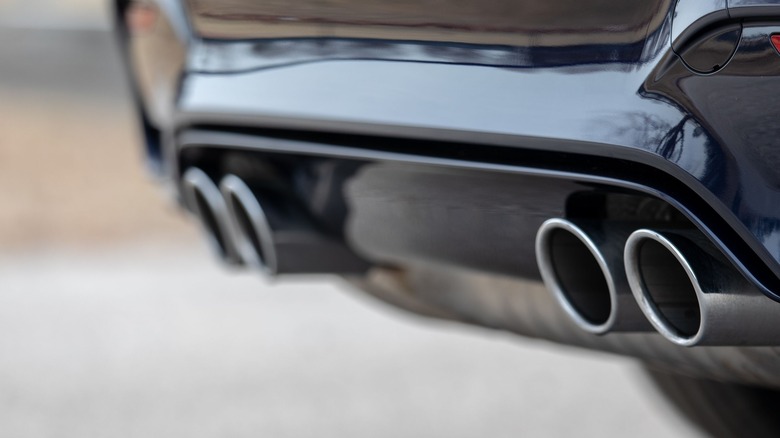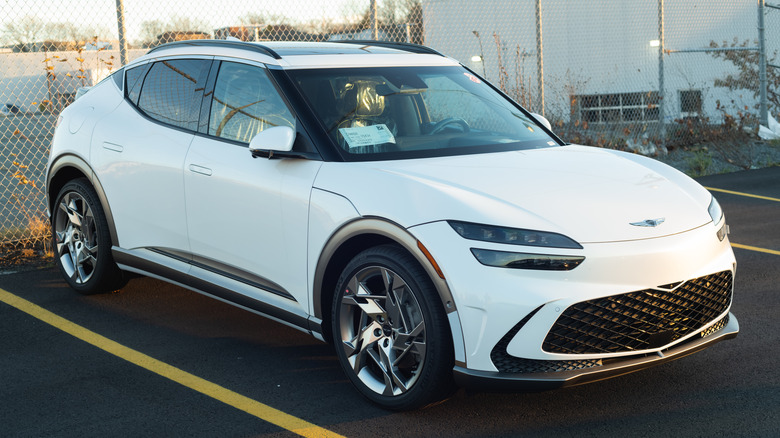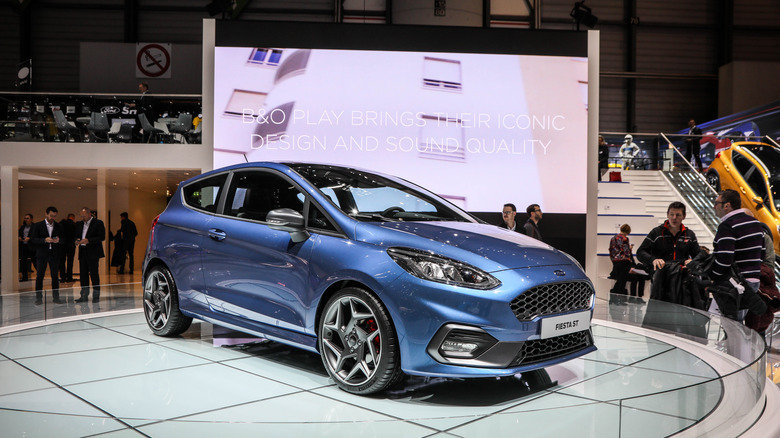What Does Sport Mode Actually Do In Most Cars?
It feels like sport mode buttons are everywhere. Everything, from sports cars (naturally) to SUVs of every conceivable size and shape, has a sport button, ready and waiting to be pressed by a driver curious of what hidden potential it might unlock.
Arriving first on automatic transmissions, sport mode has been around for decades but only recently spread to almost every car on the road. Its popularity has grown with the increased use of computers in cars, which can easily change the characteristics of the acceleration, steering, gears, suspension, exhaust, and brakes with the press of a button.
Since, in many cases, the driver's hands and feet are no longer physically connected to the engine or front wheels, computers bridging that gap can change how their inputs affect the car's motion. With sport mode enabled, the electric steering can be made heavier and more direct for a sportier feel, and the accelerator pedal — no longer physically connected to the engine itself — can be made more sensitive to make the car feel like it's gained 50 horsepower.
Some sport modes are far more complex, with multiple settings for drivers who want to pair a sporty engine and exhaust sound with a softer suspension setup and firm steering, for example. Cars like the BMW M4 can feel overwhelming, with multiple options of sportiness for every major control, from the steering to the brakes, and even ten levels of traction control.
How sport mode changes the engine (or motor)
Generally speaking, sport mode does not give an engine more power. Instead, you could argue that the normal mode (or other modes sometimes called eco or comfort) actually restricts the engine or electric motor. Some electric cars only deploy full power in their regular drive modes if you floor the accelerator pedal. The rest of the time, they're actually producing a fair bit less power than you might expect.
Take, for example, the new electric Jeep Avenger, which is claimed to have 115 kW of power, but in normal mode, this is restricted to 80 kW unless you press the accelerator right to the floor, triggering the kick-down switch. The power output in the car's eco mode is just 60 kW, while torque is lowered from 260 Nm in sport mode to 220 Nm in normal and 180 Nm in eco.
As well as total power, a car's sport mode often increases the sensitivity of the accelerator pedal, especially at the top of its travel. This makes the car feel more responsive, as more power is summoned in sport mode than with the same amount of pedal travel in other modes. In a Mini Cooper S, pictured above, the sport button has a marked effect on the sensitivity of the accelerator pedal.
Sport mode can make the car louder
Sticking with the Mini Cooper S for a minute, the other big difference the sport button makes concerns the exhaust. With sport mode enabled, the car intentionally allows a tiny bit of unburnt gas to reach the hot exhaust, which then explodes to create a small volley of crackles. Sometimes referred to as the overrun of an engine — or a "pop and bang map" in contemporary parlance — this is common among race cars and is easily augmented with turbocharged street cars. Does it make the car go faster? No. Does it elicit childish giggles from the driver every time they lift off the throttle? Almost certainly.
Deploying sport mode also often makes a car louder. This is usually down to the opening of valves in the exhaust system, which allow some gasses to bypass the silencer and exit the tailpipe with a louder, sportier tone. Some cars open their exhaust valves above a certain engine speed, so they are quieter while cruising at low revs and then louder when driven harder.
More recently, car manufacturers have begun augmenting the sound of a sportier exhaust using the sound system's speakers. Many manufacturers now do this, even on everyday cars, with sport mode producing a louder experience for the driver and their passengers without changing the sound emitted externally.
Sport mode on electric cars
Sport buttons that change the sound of a car are especially common among today's electric cars and across pretty much all price points. Cars like the Genesis GV60, the compact electric SUV pictured above, have a whole suite of options for fine-tuning the way the car sounds to its driver and passengers, depending on which driving mode is selected. The Ford Mustang Mach-E even has a mode that attempts to replicate the rumble of a V8 engine.
As well as extra performance and sound, electric car manufacturers like to add some theater to their sport modes. Back to the aforementioned Genesis; when sport mode is selected, the instrument display turns red, and the driver is gripped more rightly by the motorized seat bolsters. One final flourish comes with the 'boost' button on the steering wheel. Press this while in sport mode, and the car serves up an extra 60 horsepower for ten seconds, taking the total to 483 hp, not unlike the boost button in a video game.
With manufacturers and their marketing departments looking for ways to replace the character of internal combustion, we'll no doubt see more sport mode options — like tightening seats and boost mode — on many new cars. Huge power outputs have already been democratized by electric motors, and the same is now happening with the sport mode, too.
Steering and suspension
Sport mode often increases the weight of a car's steering. This is done by reducing the amount of assistance from the power steering system, which makes the steering feel heavier. It might not improve your lap times, but heavier steering can make the driver feel more involved than when the wheel feels artificially light.
Sport mode can also change the steering ratio. A higher ratio means each degree of steering lock has a greater effect on the angle of the wheels. This can make a car feel alert and more eager to turn into corners.
A car's suspension can also be adjusted with sport mode. Although rarer and more complex than a simple tweak to the accelerator sensitivity, the active air suspension of some cars can be made stiffer with a press of the sport button. Increasing damper pressure reduces roll in the corners and dive under heavy braking while adding a firmer and more purposeful feel to the ride.
Some cars have several suspension modes, with the most aggressive (like Porsche's Sport Plus) only really suitable for super-smooth race tracks. Manufacturers know ultra-stiff suspension setups can be a nuisance on the road, so the dampers can be softened on some cars while keeping the rest of the car in sport mode. Ferrari's so-called 'bumpy road mode' is particularly good at slackening off the dampers for more comfortable street use.
Even the brakes change with spirt mode
While we wouldn't class Porsches and Ferraris as "most cars," it is increasingly common to find active air suspension in less exotic vehicles, like sedans from Mercedes and Audi. The technology was even an option on the 2018 Ford Focus hatch, which let the driver adjust the ride firmness with a button.
Today's cars often have more than just a single sport mode. Using Ford as another example, the most recent generation of Fiesta ST hatchback, pictured above, has three drive modes –- Normal, Sport, and Track – each with its own mapping for the engine, brakes, and steering.
Modern brake-by-wire systems mean even the brake pedal can be modified with the press of a button. Some BMW M series cars let the driver apply a sport mode to the brakes, increasing the sensitivity at the top of the pedal travel for more bite, and many electric cars increase their regenerative braking efforts in sport mode. This slows them more aggressively for a sportier feel but also feeds more energy back into the battery.
The increasing electrification of cars — not just their drivetrains, but their steering and brakes, too — means even more potential for sport mode to change any vehicle's driving characteristics.





